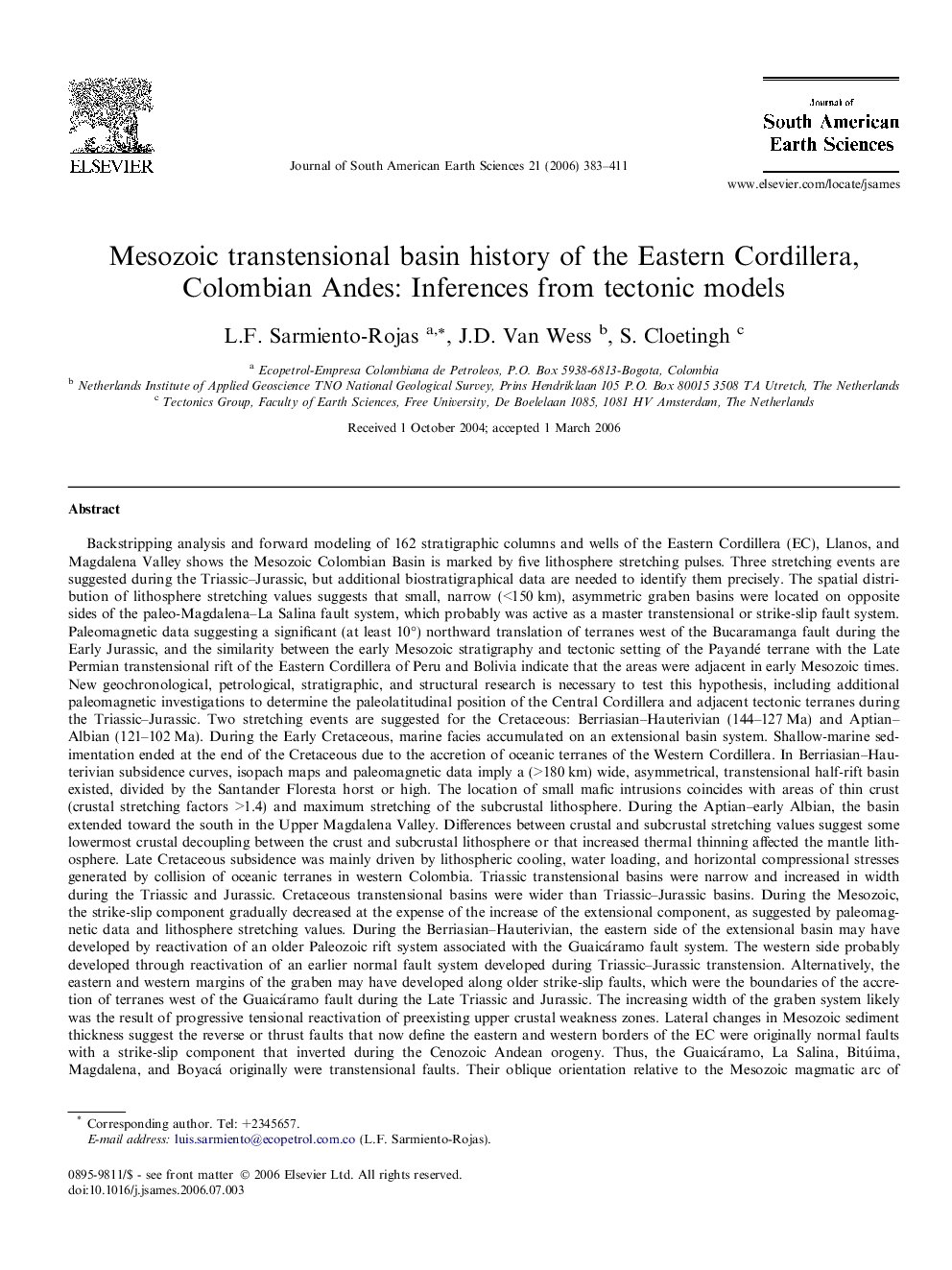| کد مقاله | کد نشریه | سال انتشار | مقاله انگلیسی | نسخه تمام متن |
|---|---|---|---|---|
| 4682935 | 1348955 | 2006 | 29 صفحه PDF | دانلود رایگان |

Backstripping analysis and forward modeling of 162 stratigraphic columns and wells of the Eastern Cordillera (EC), Llanos, and Magdalena Valley shows the Mesozoic Colombian Basin is marked by five lithosphere stretching pulses. Three stretching events are suggested during the Triassic–Jurassic, but additional biostratigraphical data are needed to identify them precisely. The spatial distribution of lithosphere stretching values suggests that small, narrow (<150 km), asymmetric graben basins were located on opposite sides of the paleo-Magdalena–La Salina fault system, which probably was active as a master transtensional or strike-slip fault system. Paleomagnetic data suggesting a significant (at least 10°) northward translation of terranes west of the Bucaramanga fault during the Early Jurassic, and the similarity between the early Mesozoic stratigraphy and tectonic setting of the Payandé terrane with the Late Permian transtensional rift of the Eastern Cordillera of Peru and Bolivia indicate that the areas were adjacent in early Mesozoic times. New geochronological, petrological, stratigraphic, and structural research is necessary to test this hypothesis, including additional paleomagnetic investigations to determine the paleolatitudinal position of the Central Cordillera and adjacent tectonic terranes during the Triassic–Jurassic. Two stretching events are suggested for the Cretaceous: Berriasian–Hauterivian (144–127 Ma) and Aptian–Albian (121–102 Ma). During the Early Cretaceous, marine facies accumulated on an extensional basin system. Shallow-marine sedimentation ended at the end of the Cretaceous due to the accretion of oceanic terranes of the Western Cordillera. In Berriasian–Hauterivian subsidence curves, isopach maps and paleomagnetic data imply a (>180 km) wide, asymmetrical, transtensional half-rift basin existed, divided by the Santander Floresta horst or high. The location of small mafic intrusions coincides with areas of thin crust (crustal stretching factors >1.4) and maximum stretching of the subcrustal lithosphere. During the Aptian–early Albian, the basin extended toward the south in the Upper Magdalena Valley. Differences between crustal and subcrustal stretching values suggest some lowermost crustal decoupling between the crust and subcrustal lithosphere or that increased thermal thinning affected the mantle lithosphere. Late Cretaceous subsidence was mainly driven by lithospheric cooling, water loading, and horizontal compressional stresses generated by collision of oceanic terranes in western Colombia. Triassic transtensional basins were narrow and increased in width during the Triassic and Jurassic. Cretaceous transtensional basins were wider than Triassic–Jurassic basins. During the Mesozoic, the strike-slip component gradually decreased at the expense of the increase of the extensional component, as suggested by paleomagnetic data and lithosphere stretching values. During the Berriasian–Hauterivian, the eastern side of the extensional basin may have developed by reactivation of an older Paleozoic rift system associated with the Guaicáramo fault system. The western side probably developed through reactivation of an earlier normal fault system developed during Triassic–Jurassic transtension. Alternatively, the eastern and western margins of the graben may have developed along older strike-slip faults, which were the boundaries of the accretion of terranes west of the Guaicáramo fault during the Late Triassic and Jurassic. The increasing width of the graben system likely was the result of progressive tensional reactivation of preexisting upper crustal weakness zones. Lateral changes in Mesozoic sediment thickness suggest the reverse or thrust faults that now define the eastern and western borders of the EC were originally normal faults with a strike-slip component that inverted during the Cenozoic Andean orogeny. Thus, the Guaicáramo, La Salina, Bitúima, Magdalena, and Boyacá originally were transtensional faults. Their oblique orientation relative to the Mesozoic magmatic arc of the Central Cordillera may be the result of oblique slip extension during the Cretaceous or inherited from the pre-Mesozoic structural grains. However, not all Mesozoic transtensional faults were inverted.
Journal: Journal of South American Earth Sciences - Volume 21, Issue 4, September 2006, Pages 383–411